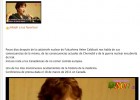Cargando...
Recursos educativos
-
Nivel educativo
-
Competencias
-
Tipología
-
Idioma
-
Tipo de medio
-
Tipo de actividad
-
Destinatarios
-
Tipo de audiencia
-
Creador
-

Learn. Measure your heart and breathing rates
EduBook Organización
- 3640 visitas
What do we do? Our circulatory and respiratory systems are constantly adapting to our body's needs. You can test this with the following experiment. While you are resting, check your pulse and count…
-

Introduction - Matter: Mass, Volume and Density
EduBook Organización
- 3618 visitas
All objects are made up of matter. As a consequence of this, they have mass, occupy a certain volume and have a certain density. Mass, volume and density are magnitudes. This means they have values…
-

Complete - Remember
EduBook Organización
- 3604 visitas
Complete: There are two types of machines: machines and machines. Levers, wheels, ramps and are examples of simple machines. Compound machines are made up of two or more machines working together.…
-

Before you read 01 - How the Leopard Got His Spots (part one)
EduBook Organización
- 3333 visitas
Read the text and complete the information below. Giraffes Giraffes are very tall animals. They are light brown with a lot of dark brown patches on their body. They have long legs and a very long neck.…
-

Blood circulation (II)
EduBook Organización
- 3559 visitas
The heart The heart is the organ that pumps blood to all the cells in our body. It is about the size of a closed fist. Its walls are made of muscle tissue. The heart contains four chambers: The two top…
-

-

Answer. Unicellular and multicellular organisms
EduBook Organización
- 3393 visitas
Remember what you have studied in this section and answer the questions: What are organisms made up of a single cell called? How do they reproduce? What do we call living things that are made up of many…
-

Video: Nuclear radiations in 3Mile Island, Chernobyl and Fukushima
Educatube Organización
- 7588 visitas
In this 11 minute video (with Spanish subtitles) Helen Caldicott (Nobel Prize) explains the consequences of recent nuclear catastrophes on the human body. We can listen to specific scientific vocabulary…
-

How we breathe in places with no air
EduBook Organización
- 3378 visitas
We need air to breathe Humans and other animals that live on land need air to live. When we breathe, we take oxygen from the air. With this oxygen and with the food we eat, our body has the energy it…
-

Te estamos redirigiendo a la ficha del libro...












